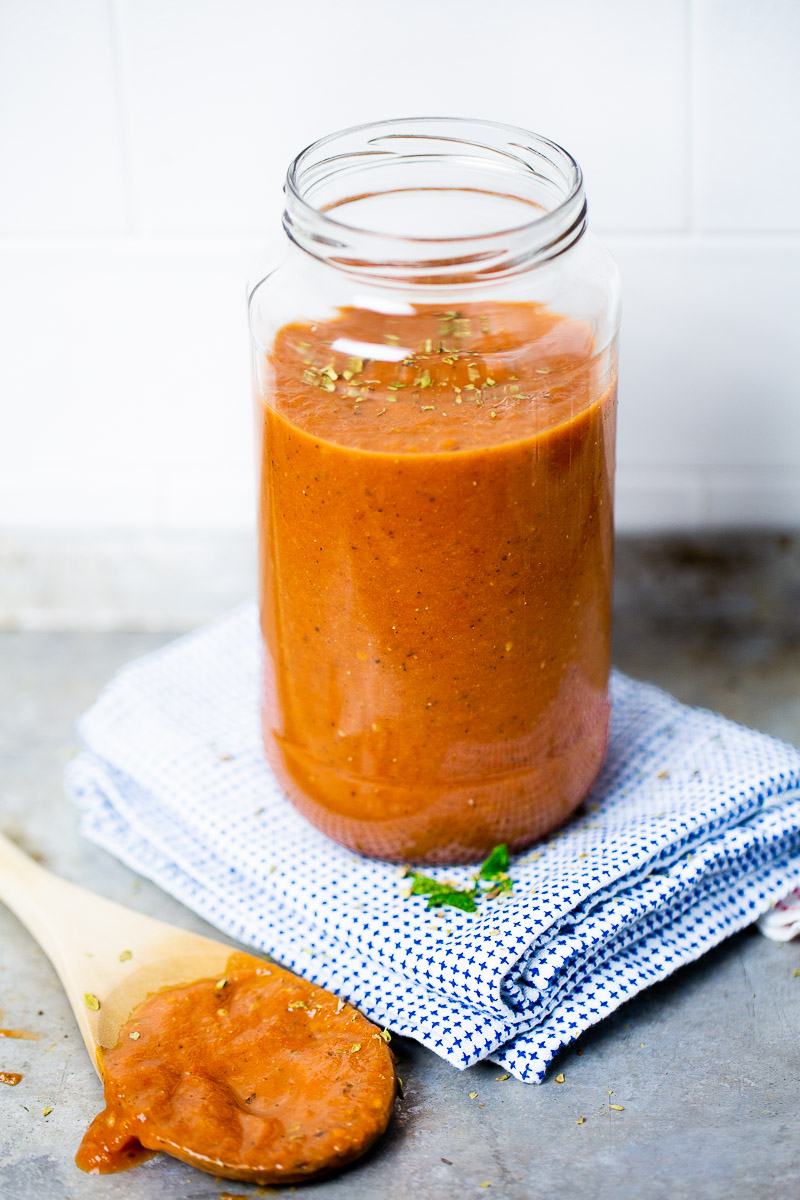
About this recipe
Want a mouth-watering homemade tomato sauce? Try this easy oven recipe! It’s perfect for pasta, soups, and any dish with canned tomatoes. Make it ahead and enjoy it anytime!
Ingredients for homemade tomato sauce
- Tomato. You can use Roma tomatoes, cherry tomatoes, San Marzano tomatoes, or any type of whole tomato that you like. I usually use whichever tomato is on sale or in season. I even mix different tomatoes, and the flavor is always outstanding.
- Garlic. Onion.
- Fresh Herbs are optional. Sometimes, I add them, and sometimes, I do not. Other times, I add oregano, basil, or other fresh herbs like parsley, rosemary, and thyme.

How to choose the best tomato
When it comes to making tomato sauce, not all tomatoes are created equal. The ideal tomatoes for a rich and flavorful tomato sauce are those that are ripe, have low water content, and are full of natural flavors. Some of the best tomato varieties for making a delicious tomato sauce are:
- Roma tomatoes: These tomatoes are great for making all-purpose sauce since they are meaty and have a low water content, resulting in a thick and flavorful sauce.
- San Marzano tomatoes: Many people consider these tomatoes grown in Italy’s volcanic soil of Mount Vesuvius to be the best for tomato sauce due to their unique flavor and texture.
- Cherokee Purple tomatoes: These tomatoes have a deep purple color and a rich, sweet flavor. Although they are not as meaty as Roma tomatoes, they can still be used to make a flavorful and unique tomato sauce.
- Plum tomatoes: These tomatoes are ideal for tomato sauce due to their low water content and meaty texture. They are similar to Roma tomatoes, but have a more elongated shape and are slightly smaller.
Tips for buying the best tomatoes
Choose firm and deep red tomatoes for the delicious tomato sauce, avoiding green or soft ones.
- Buy tomatoes that are in season. Tomatoes that are in season will be more flavorful and have a better texture.
- Look for tomatoes that are locally grown. Locally grown tomatoes will be fresher and have a better flavor than tomatoes that have been shipped long distances.
- Avoid tomatoes that have been bruised or damaged. Bruised or damaged tomatoes will not taste as good and may be unsafe to eat.
HOW TO MAKE TOMATO SAUCE AT HOME?
To make the sauce, place all the ingredients in a baking dish, bake in the oven, blend, and store in a jar or use right away. It can be refrigerated or frozen for future use.

HOW TO USE THE healthy HOMEMADE TOMATO SAUCE?
This sauce can be used in any recipe that requires tomato puree. For example, Pasta with tomato sauce and onion in a single pot, Puttanesca pasta, Ricotta stuffed shells, Pizza
Make marinara sauce, or spaghetti sauce, or use it on top of your favorite meatballs or homemade pasta. You can also use it as-is and pour it over cooked pasta for a very simple pasta recipe.
You can serve it as a soup with a vegan quesadilla or a grilled cheese sandwich. You can also use it as a base to make a vegetable soup or, if you make it without basil, for any vegan Mexican recipe.
Tips for a Perfect Sauce Every Time
- Troubleshooting: If the soup is too watery, Allow it to simmer for a longer time. If it is too thick, Add vegetable broth or filtered water to reach your desired consistency.
- Flavoring: Herbs, spices, and a variety of vegetables can elevate your sauce. Whether it’s the tang of basil or the earthiness of roasted bell peppers, the flavor profiles you can achieve are endless.
- Make it spicy by adding red pepper flakes.
- More vegetables: add celery and carrots
- Make it super-rich by adding butter ( I use vegan butter) and a drizzle of olive oil.

Homemade tomato sauce (oven recipe)
Equipment
- Baking dish
- Blender, immersion blender or food processor
Instructions
- Preheat the oven to 300 degrees Fahrenheit.
- Cut the tomatoes and onion into large pieces or halves.
- Take a baking dish and place the basil in the center (if using). Cover the basil with a layer of onion and tomato.
- Add the garlic and drizzle with olive oil generously.
- Bake until the tomatoes and onions show a bit of char on the skin and there are a lot of juices in the baking dish.
- Peel the garlic and blend until smooth or to your desired consistency.
Notes
- If adding peeled garlic, hide it under the tomatoes. If adding unpeeled, let it roast with the rest of the ingredients.
- Cooling: It’s important to let homemade tomato sauce cool to room temperature before storing it to prevent early spoilage due to condensation inside the container.
-
Choosing the Right Container:
- Glass Jars: These are ideal for storing tomato sauce because they don’t absorb flavors or odors. Ensure they’re cleaned and sterilized.
- Plastic Containers: If using plastic, ensure it’s food-safe and BPA-free. Tomato sauce is acidic, and you want to avoid chemicals leaching into your sauce.
- Vacuum-Sealed Bags: These are great for freezing and can save a lot of space.
-
Refrigeration:
- If you plan to consume the tomato sauce within 5-7 days, refrigerating it is the way to go.
- Pour the cooled sauce into your chosen container, leaving about an inch of space at the top for expansion.
- Seal the container tightly to prevent air (and potential contaminants) from getting in.
- Always use a clean spoon when serving to prevent introducing any contaminants.
-
Freezing:
- For more extended storage, freezing homemade tomato sauce is an excellent option.
- Divide the sauce into portion-sized containers or vacuum-sealed bags. This way, you can thaw just the amount you need.
- Label each container or bag with the date. Homemade tomato sauce can be stored in the freezer for 4-6 months.
- When ready to use the sauce, transfer it to the refrigerator for thawing, ideally a day before you need it. You can use the defrost setting on your microwave for a quicker method.
Nutrition
information
Nutritional information of this recipe is only an estimate, the accuracy for any recipe on this site is not guaranteed.
This recipe appeared first in 2013.
